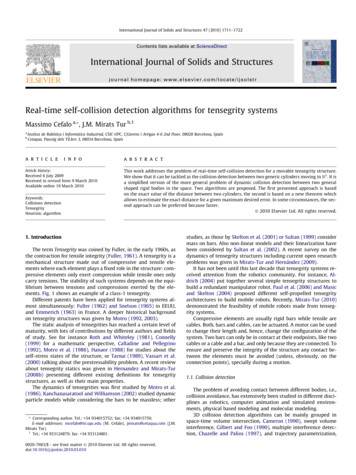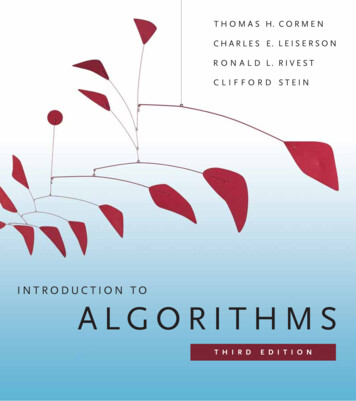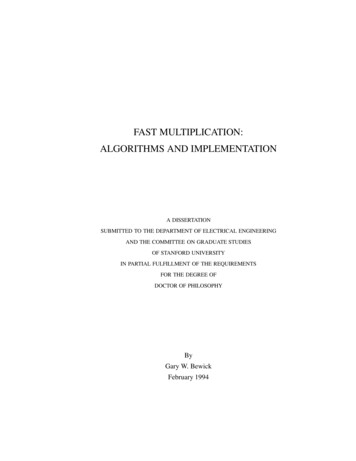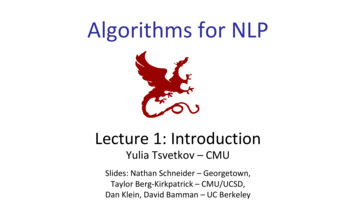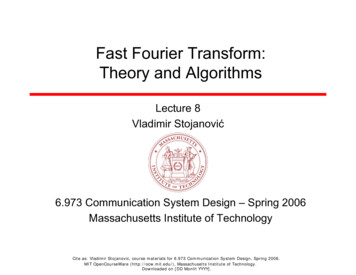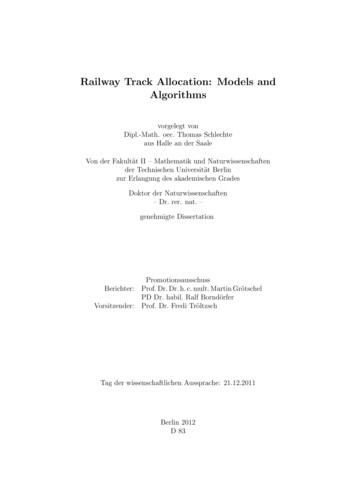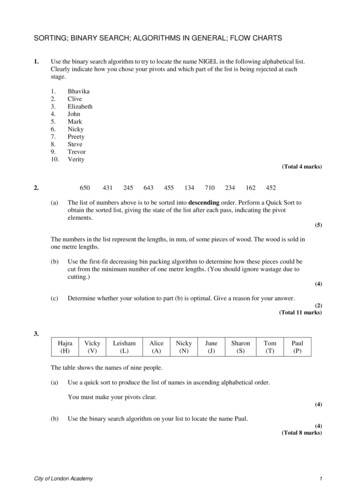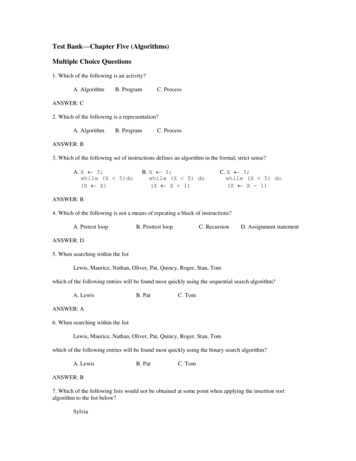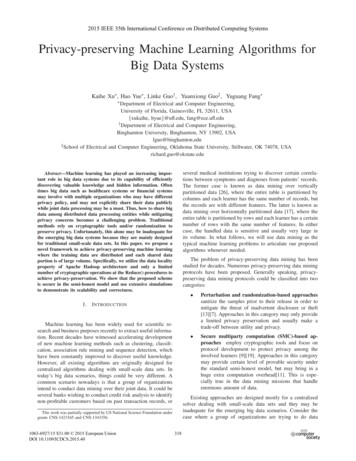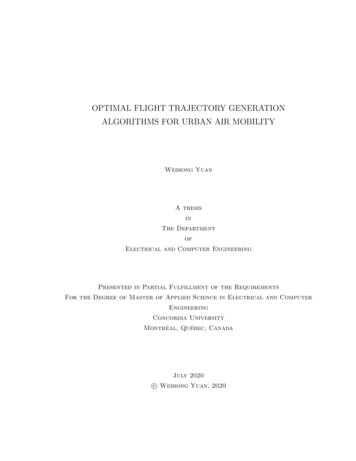![Algorithms AppendixI:ProofbyInduction[Sp’16]](/img/13/98-induction.jpg)
Transcription
AlgorithmsAppendix I: Proof by Induction [Sp’16]Jeder Genießende meint, dem Baume habe es an der Frucht gelegen;aber ihm lag am Samen.[Everyone who enjoys thinks that the fundamental thing about trees is the fruit,but in fact it is the seed.]— Friedrich Wilhelm Nietzsche,Vermischte Meinungen und Sprüche [Mixed Opinions and Maxims] (1879)In view of all the deadly computer viruses that have been spreading lately,Weekend Update would like to remind you:When you link up to another computer,you’re linking up to every computer that that computer has ever linked up to.— Dennis Miller, “Saturday Night Live”, (c. 1985)Anything that, in happening, causes itself to happen again, happens again.— Douglas Adams (2005)The Curling Stone slides; and, having slid,Passes me toward thee on this Icy Grid,If what’s reached is passed for’ll Crystals amid,Th’Stone Reaches thee in its Eternal Skid.— Iraj Kalantari (2007)writing as “Harak A’Myomy (12th century),translated by Walt Friz De Gradde (1897)”Proof by InductionInduction is a method for proving universally quantified propositions—statements about allelements of a (usually infinite) set. Induction is also the single most useful tool for reasoningabout, developing, and analyzing algorithms. These notes give several examples of inductiveproofs, along with a standard boilerplate and some motivation to justify (and help you remember)why induction works.1Prime Divisors: Proof by Smallest CounterexampleA divisor of a positive integer n is a positive integer p such that the ratio n/p is an integer. Theinteger 1 is a divisor of every positive integer (because n/1 n), and every integer is a divisor ofitself (because n/n 1). A proper divisor of n is any divisor of n other than n itself. A positiveinteger is prime if it has exactly two divisors, which must be 1 and itself; equivalently; a numberis prime if and only if 1 is its only proper divisor. A positive integer is composite if it has morethan two divisors (or equivalently, more than one proper divisor). The integer 1 is neither primenor composite, because it has exactly one divisor, namely itself.Let’s prove our first theorem:Theorem 1. Every integer greater than 1 has a prime divisor.The very first thing that you should notice, after reading just one word of the theorem, is thatthis theorem is universally quantified—it’s a statement about all the elements of a set, namely,the set of positive integers larger than 1. If we were forced at gunpoint to write this sentence Copyright 2018 Jeff Erickson.This work is licensed under a Creative Commons License ).Free distribution is strongly encouraged; commercial distribution is expressly forbidden.See http://jeffe.cs.illinois.edu/teaching/algorithms/ for the most recent revision.1
AlgorithmsAppendix I: Proof by Induction [Sp’16]using fancy logic notation, the first character would be the universal quantifier , pronounced‘for all’. Fortunately, that won’t be necessary.There are only two ways to prove a universally quantified statement: directly or by contradiction. Let’s say that again, louder: There are only two ways to prove a universally quantifiedstatement: directly or by contradiction. Here are the standard templates for these two methods,applied to Theorem 1:Direct proof: Let n be an arbitrary integer greater than 1. . . blah blah blah . . .Thus, n has at least one prime divisor. Proof by contradiction: For the sake of argument, assume there is an integergreater than 1 with no prime divisor.Let n be an arbitrary integer greater than 1 with no prime divisor. . . blah blah blah . . .But that’s just silly. Our assumption must be incorrect. The shaded boxes . . . blah blah blah . . . indicate missing proof details (that you will fill in).Most people usually find proofs by contradiction easier to discover than direct proofs, so let’stry that first.Proof by contradiction: For the sake of argument, assume there is an integergreater than 1 with no prime divisor.Let n be an arbitrary integer greater than 1 with no prime divisor.Since n is a divisor of n, and n has no prime divisors, n cannot be prime.Thus, n must have at least one divisor d such that 1 d n.Let d be an arbitrary divisor of n such that 1 d n.Since n has no prime divisors, d cannot be prime.Thus, d has at least one divisor d 0 such that 1 d 0 d .Let d 0 be an arbitrary divisor of d such that 1 d 0 d .Because d/d 0 is an integer, n/d 0 (n/d) · (d/d 0 ) is also an integer.Thus, d 0 is also a divisor of n.Since n has no prime divisors, d 0 cannot be prime.Thus, d 0 has at least one divisor d such that 1 d d 0 .Let d be an arbitrary divisor of d 0 such that 1 d d 0 .Because d 0 /d is an integer, n/d (n/d 0 ) · (d 0 /d ) is also an integer.Thus, d is also a divisor of n.Since n has no prime divisors, d cannot be prime. . . blah HELP! blah I’M STUCK IN AN INFINITE LOOP! blah . . .But that’s just silly. Our assumption must be incorrect. We seem to be stuck in an infinite loop, looking at smaller and smaller divisors d d 0 d · · · , none of which are prime. But this loop can’t really be infinite. There are only n 1 positiveintegers smaller than n, so the proof must end after at most n 1 iterations. But how do we turnthis observation into a formal proof? We need a single, self-contained proof for all integers n;we’re not allowed to write longer proofs for bigger integers. The trick is to jump directly to thesmallest counterexample.2
AlgorithmsAppendix I: Proof by Induction [Sp’16]Proof by smallest counterexample: For the sake of argument, assume thatthere is an integer greater than 1 with no prime divisor.Let n be the smallest integer greater than 1 with no prime divisor.Since n is a divisor of n, and n has no prime divisors, n cannot be prime.Thus, n has a divisor d such that 1 d n.Let d be a divisor of n such that 1 d n.Because n is the smallest counterexample, d has a prime divisor.Let p be a prime divisor of d .Because d/p is an integer, n/p (n/d) · (d/p) is also an integer.Thus, p is also a divisor of n.But this contradicts our assumption that n has no prime divisors!So our assumption must be incorrect. Hooray, our first proof! We’re done!Um. . . well. . . no, we’re definitely not done. That’s a first draft up there, not a final polishedproof. We don’t write proofs just to convince ourselves; proofs are primarily a tool to convinceother people. (In particular, ‘other people’ includes the people grading your homeworks andexams.) And while proofs by contradiction are usually easier to write, direct proofs are almostalways easier to read. So as a service to our audience (and our grade), let’s transform ourminimal-counterexample proof into a direct proof.Let’s first rewrite the indirect proof slightly, to make the structure more apparent. First, webreak the assumption that n is the smallest counterexample into three simpler assumptions:(1) n is an integer greater than 1; (2) n has no prime divisors; and (3) there are no smallercounterexamples. Second, instead of dismissing the possibility than n is prime out of hand, weinclude an explicit case analysis.Proof by smallest counterexample: Let n be an arbitrary integer greater than 1.For the sake of argument, suppose n has no prime divisor.Assume that every integer k such that 1 k n has a prime divisor.There are two cases to consider: Either n is prime, or n is composite. Suppose n is prime.Then n is a prime divisor of n. Suppose n is composite.Then n has a divisor d such that 1 d n.Let d be a divisor of n such that 1 d n.Because no counterexample is smaller than n , d has a prime divisor.Let p be a prime divisor of d .Because d/p is an integer, n/p (n/d) · (d/p) is also an integer.Thus, p is a prime divisor of n.In each case, we conclude that n has a prime divisor.But this contradicts our assumption that n has no prime divisors!So our assumption must be incorrect. Now let’s look carefully at the structure of this proof. First, we assumed that the statementwe want to prove is false. Second, we proved that the statement we want to prove is true. Finally,we concluded from the contradiction that our assumption that the statement we want to prove isfalse is incorrect, so the statement we want to prove must be true.But that’s just silly. Why do we need the first and third steps? After all, the second step isa proof all by itself! Unfortunately, this redundant style of proof by contradiction is extremelycommon, even in professional papers. Fortunately, it’s also very easy to avoid; just remove thefirst and third steps!3
AlgorithmsAppendix I: Proof by Induction [Sp’16]Proof by induction: Let n be an arbitrary integer greater than 1.Assume that every integer k such that 1 k n has a prime divisor.There are two cases to consider: Either n is prime or n is composite. First, suppose n is prime.Then n is a prime divisor of n. Now suppose n is composite.Then n has a divisor d such that 1 d n.Let d be a divisor of n such that 1 d n.Because no counterexample is smaller than n , d has a prime divisor.Let p be a prime divisor of d .Because d/p is an integer, n/p (n/d) · (d/p) is also an integer.Thus, p is a prime divisor of n.In both cases, we conclude that n has a prime divisor. This style of proof is called induction.1 The assumption that there are no counterexamplessmaller than n is called the induction hypothesis. The two cases of the proof have differentnames. The first case, which we argue directly, is called the base case. The second case, whichactually uses the induction hypothesis, is called the inductive case. You may find it helpful toactually label the induction hypothesis, the base case(s), and the inductive case(s) in your proof.The following point cannot be emphasized enough: The only difference between a proof byinduction and a proof by smallest counterexample is the way we write down the argument. Theessential structure of the proofs are exactly the same. The core of our original indirect argumentis a proof of the following implication for all n:n has no prime divisor some number smaller than n has no prime divisor.The core of our direct proof is the following logically equivalent implication:every number smaller than n has a prime divisor n has a prime divisorThe left side of this implication is just the induction hypothesis.The proofs we’ve been playing with have been very careful and explicit; until you’recomfortable writing your own proofs, you should be equally careful. A more mature proof-writermight express the same proof more succinctly as follows:Proof by induction: Let n be an arbitrary integer greater than 1. Assume thatevery integer k such that 1 k n has a prime divisor. If n is prime, then n is aprime divisor of n. On the other hand, if n is composite, then n has a proper divisor;call it d . The induction hypothesis implies that d has a prime divisor p. The integer pis also a divisor of n. A proof in this more succinct form is still worth full credit, provided the induction hypothesis iswritten explicitly and the case analysis is obviously exhaustive.A professional mathematician would write the proof even more tersely:Proof: Induction. And you can write that tersely, too, when you’re a professional mathematician.1Many authors use the high-falutin’ name the principle of mathematical induction, to distinguish it from inductivereasoning, the informal process by which we conclude that pigs can’t whistle, horses can’t fly, and NP-hard problemscannot be solved in polynomial time. We already know that every proof is mathematical (and arguably, all mathematicsis proof), so as a description of a proof technique, the adjective ‘mathematical’ is simply redundant.4
Algorithms2Appendix I: Proof by Induction [Sp’16]The Axiom of InductionWhy does this work? Well, let’s step back to the original proof by smallest counterexample.How do we know that a smallest counterexample exists? This seems rather obvious, but in fact,it’s impossible to prove without using the following seemingly trivial observation, called theWell-Ordering Principle:Every non-empty set of positive integers has a smallest element.Every set X of positive integers is the set of counterexamples to some proposition P(n) (specifically,the proposition n 6 X ). Thus, the Well-Ordering Principle can be rewritten as follows:If the proposition P(n) is false for some positive integer n,thenthe proposition (P(1) P(2) · · · P(n 1) P(n)) is true for some positive integer n.Equivalently, in English:If some statement about positive integers has a counterexample,thenthat statement has a smallest counterexample.We can write this implication in contrapositive form as follows:If the proposition (P(1) P(2) · · · P(n 1) P(n)) is false for every positive integer n,thenthe proposition P(n) is true for every positive integer n.or less formally,If some statement about positive integers has no smallest counterexample,thenthat statement is true for all positive integers.Finally, let’s rewrite the first half of this statement in a logically equivalent form, by replacing (p q) with p q.If the implication (P(1) P(2) · · · P(n 1)) P(n) is true for every positive integer n,thenthe proposition P(n) is true for every positive integer n.This formulation is usually called the Axiom of Induction. In a proof by induction that P(n)holds for all n, the conjunction (P(1) P(2) · · · P(n 1)) is the inductive hypothesis.A proof by induction for the proposition “P(n) for every positive integer n” is nothing but adirect proof of the more complex proposition “(P(1) P(2) · · · P(n 1)) P(n) for everypositive integer n”. Because it’s a direct proof, it must start by considering an arbitrary positiveinteger, which we might as well call n. Then, to prove the implication, we explicitly assume thehypothesis (P(1) P(2) · · · P(n 1)) and then prove the conclusion P(n) for that particularvalue of n. The proof almost always breaks down into two or more cases, each of which may ormay not actually use the inductive hypothesis.Here is the boilerplate for every induction proof. Read it. Learn it. Use it.5
AlgorithmsAppendix I: Proof by Induction [Sp’16]Theorem: P(n) for every positive integer n.Proof by induction: Let n be an arbitrary positive integer.Assume that P(k) is true for every positive integer k n.There are several cases to consider: Suppose n is . . . blah blah blah . . .Then P(n) is true. Suppose n is . . . blah blah blah . . .The inductive hypothesis implies that . . . blah blah blah . . .Thus, P(n) is true.In each case, we conclude that P(n) is true. Or more generally:Bellman’s Theorem: Every snark is a boojum.Proof by induction: Let X be an arbitrary snark.Assume that for every snark younger than X is a boojum.There are three cases to consider: Suppose X is the youngest snark.Then . . . blah blah blah . . . Suppose X is the second-youngest snark.Then . . . blah blah blah . . . Suppose X is older than the second-youngest snark.Then the inductive hypothesis implies . . . blah blah blah . . .and therefore. . . blah blah blah . . .An all cases, we conclude that X is a boojum. Some textbooks distinguish between several different types of induction: ‘regular’ inductionversus ‘strong’ induction versus ‘complete’ induction versus ‘structural’ induction versus ‘transfinite’induction versus ‘Noetherian’ induction. Distinguishing between these different types of inductionis pointless hairsplitting; I won’t even define them. Every ‘different type’ of induction proof isprovably equivalent to a proof by smallest counterexample. (Later we will consider inductiveproofs of statements about partially ordered sets other than the positive integers, for which‘smallest’ has a different meaning, but this difference will prove to be inconsequential.)3Stamps and RecursionLet’s move on to a completely different example.Theorem 2. Given an unlimited supply of 5-cent stamps and 7-cent stamps, we can make anyamount of postage larger than 23 cents.We could prove this by contradiction, using a smallest-counterexample argument, but let’saim for a direct proof by induction this time. We start by writing down the induction boilerplate,using the standard induction hypothesis: There is no counterexample smaller than n.6
AlgorithmsAppendix I: Proof by Induction [Sp’16]Proof by induction: Let n be an arbitrary integer greater than 23.Assume that for any integer k such that 23 k n, we can make k cents inpostage. . . blah blah blah . . .Thus, we can make n cents in postage. How do we fill in the details? One approach is to think about what you would actually do ifyou really had to make n cents in postage. For example, you might start with a 5-cent stamp,and then try to make n 5 cents in postage. The inductive hypothesis says you can make anyamount of postage bigger than 23 cents and less than n cents. So if n 5 23, then you alreadyknow that you can make n 5 cents in postage! (You don’t know how to make n 5 cents inpostage, but so what?)Let’s write this observation into our proof as two separate cases: either n 28 (where ourapproach works) or n 28 (where we don’t know what to do yet).Proof by induction: Let n be an arbitrary integer greater than 23.Assume that for any integer k such that 23 k n, we can make k cents inpostage.There are two cases to consider: Either n 28 or n 28. Suppose n 28.Then 23 n 5 n.Thus, the induction hypothesis implies that we can make n 5 cents inpostage.Adding one more 5-cent stamp gives us n cents in postage. Now suppose n 28. . . blah blah blah . . .In both cases, we can make n cents in postage. What do we do in the second case? Fortunately, this case considers only five integers: 24,25, 26, 27, and 28. There might be a clever way to solve all five cases at once, but why bother?They’re small enough that we can find a solution by brute force in less than a minute. To makethe proof more readable, I’ll unfold the nested cases and list them in increasing order.Proof by induction: Let n be an arbitrary integer greater than 23.Assume that for any integer k such that 23 k n, we can make k cents inpostage.There are six cases to consider: n 24, n 25, n 26, n 27, n 28, andn 28. 24 7 7 5 525 5 5 5 5 526 7 7 7 527 7 5 5 5 528 7 7 7 7Suppose n 28.Then 23 n 5 n.Thus, the induction hypothesis implies that we can make n 5 cents inpostage.Adding one more 5-cent stamp gives us n cents in postage.In all cases, we can make n cents in postage. Voilà! An induction proof! More importantly, we now have a recipe for discovering inductionproofs.7
AlgorithmsAppendix I: Proof by Induction [Sp’16]1. Write down the boilerplate. Write down the universal invocation (‘Let n be an arbitrary. . . ’), the induction hypothesis, and the conclusion, with enough blank space for theremaining details. Don’t be clever. Don’t even think. Just write. This is the easy part. Toemphasize the common structure, the boilerplate will be indicated in green for the rest ofthis handout.2. Think big. Don’t think how to solve the problem all the way down to the ground; you’llonly make yourself dizzy. Don’t think about piddly little numbers like 1 or 5 or 10100 .Instead, think about how to reduce the proof about some absfoluckingutely ginormous valueof n to a proof about some other number(s) smaller than n. This is the hard part.3. Look for holes. Look for cases where your inductive argument breaks down. Solve thosecases directly. Don’t be clever here; be stupid but thorough.4. Rewrite everything. Your first proof is a rough draft. Rewrite the proof so that yourargument is easier for your (unknown?) reader to follow.The cases in an inductive proof always fall into two categories. Any case that uses the inductivehypothesis is called an inductive case. Any case that does not use the inductive hypothesis iscalled a base case. Typically, but not always, base cases consider a few small values of n, and theinductive cases consider everything else. Induction proofs are usually clearer if we present thebase cases first, but I find it much easier to discover the inductive cases first. In other words, Irecommend writing induction proofs backwards.Well-written induction proofs very closely resemble well-written recursive programs. Wecomputer scientists use induction primarily to reason about recursion, so maintaining thisresemblance is extremely useful—we only have to keep one mental pattern, called ‘induction’when we’re writing proofs and ‘recursion’ when we’re writing code. Consider the following Cand Scheme programs for making n cents in postage:void postage(int n){assert(n 23);switch ( n ){case 24: printf("7 7 5 5");case 25: printf("5 5 5 5 5");case 26: printf("7 7 7 5");case 27: printf("7 5 5 5 5");case 28: printf("7 7 7 7");default:postage(n-5);printf(" 5");}}break;break;break;break;break;(define (postage n)(cond (( n 24) (5 5 7 7))(( n 25) (5 5 5 5 5))(( n 26) (5 7 7 7))(( n 27) (5 5 5 5 7))(( n 28) (7 7 7 7))(( n 28) (cons 5 (postage (- n 5))))))8
AlgorithmsAppendix I: Proof by Induction [Sp’16]The C program begins by declaring the input parameter (“Let n be an arbitrary integer. . . ")and asserting its range (“. . . greater than 23."). (Scheme programs don’t have type declarations.)In both languages, the code branches into six cases: five that are solved directly, plus one that ishandled by invoking the inductive hypothesis recursively.4More on Prime DivisorsBefore we move on to different examples, let’s prove another fact about prime numbers:Theorem 3. Every positive integer is a product of prime numbers.First, let’s write down the boilerplate. Hey! I saw that! You were thinking, weren’t you? Stopthat this instant! Don’t make me turn the car around. First we write down the boilerplate.Proof by induction: Let n be an arbitrary positive integer.Assume that any positive integer k n is a product of prime numbers.There are some cases to consider:. . . blah blah blah . . .Thus, n is a product of prime numbers. Now let’s think about how you would actually factor a positive integer n into primes. Thereare a couple of different options here. One possibility is to find a prime divisor p of n, asguaranteed by Theorem 1, and recursively factor the integer n/p. This argument works as longas n 2, but what about n 1? The answer is simple: 1 is the product of the empty set of primes.What else could it be?Proof by induction: Let n be an arbitrary positive integer.Assume that any positive integer k n is a product of prime numbers.There are two cases to consider: either n 1 or n 2. If n 1, then n is the product of the elements of the empty set, each of whichis prime, green, sparkly, vanilla, and hemophagic. Suppose n 1. Let p be a prime divisor of n, as guaranteed by Theorem 2.The inductive hypothesis implies that the positive integer n/p is a product ofprimes, and clearly n (n/p) · p.In both cases, n is a product of prime numbers. But an even simpler method is to factor n into any two proper divisors, and recursivelyhandle them both. This method works as long as n is composite, since otherwise there is no wayto factor n into smaller integers. Thus, we need to consider prime numbers separately, as well asthe special case 1.9
AlgorithmsAppendix I: Proof by Induction [Sp’16]Proof by induction: Let n be an arbitrary positive integer.Assume that any positive integer k n is a product of prime numbers.There are three cases to consider: either n 1, n is prime, or n is composite. If n 1, then n is the product of the elements of the empty set, each of whichis prime, red, broody, chocolate, and lycanthropic. If n is prime, then n is the product of one prime number, namely n. Suppose n is composite. Let d be any proper divisor of n (guaranteed by thedefinition of ‘composite’), and let m n/d . Since both d and m are positiveintegers smaller than n, the inductive hypothesis implies that d and m areboth products of prime numbers. We clearly have n d · m.In both cases, n is a product of prime numbers.5 SummationsHere’s an easy one.Theorem 4.nXi 03i 3n 1 1for every non-negative integer n.2First let’s write down the induction boilerplate, which empty space for details we’ll fill inlater.Proof by induction: Let n be an arbitrary non-negative integer.Assume inductively thatkXi 03i 3k 1 1for every non-negative integer k n.2There are some number of cases to consider:. . . blah blah blah . . .We conclude thatnXi 03i 3n 1 1.2 Now imagine you are part of an infinitely long assembly line of mathematical provers, eachassigned to a particular non-negative integer. Your task is to prove this theorem for the integer8675310. The regulations of the Mathematical Provers Union require you not to think aboutany other integer but your own. The assembly line starts with the Senior Master Prover, whoproves the theorem for the case n 0. Next is the Assistant Senior Master Prover, who provesthe theorem for n 1. After him is the Assistant Assistant Senior Master Prover, who provesthe theorem for n 2. Then the Assistant Assistant Assistant Senior Master Prover proves thetheorem for n 3. As the work proceeds, you start to get more and more bored. You attemptstrike up a conversation with Jenny, the prover to your left, but she ignores you, preferring tofocus on the proof. Eventually, you fall into a deep, dreamless sleep. An undetermined time later,Jenny wakes you up by shouting, “Hey, doofus! It’s your turn!” As you look around, bleary-eyed,you realize that Jenny and everyone to your left has finished their proofs, and that everyone iswaiting for you to finish yours. What do you do?What you do, after wiping the droolPoff your chin, is stop and think for a moment about whatyou’re trying to prove. What does thatnotation actually mean? Intuitively, we can expand the10
AlgorithmsAppendix I: Proof by Induction [Sp’16]notation as follows:8675310X3i 30 31 · · · 38675309 38675310 .i 0Notice that this expression also contains the summation that Jenny just finished proving somethingabout:8675309X3i 30 31 · · · 38675308 38675309 .i 0Putting these two expressions together gives us the following identity:8675310Xi3 i 08675309X3i 38675310i 0PIn fact, this recursive identity is the definition of . Jenny just proved that the summation onthe right is equal to (38675310 1)/2, so we can plug that into the right side of our equation:8675310Xi3 8675309Xi 03i 38675310 i 038675310 1 38675310 .2And it’s all downhill from here. After a little bit of algebra, you simplify the right side ofthis equation to (38675311 1)/2, wake up the prover to your right, and start planning yourwell-earned vacation.Let’s insert this argument into our boilerplate, only using a generic ‘big’ integer n instead ofthe specific integer 8675310:Proof by induction: Let n be an arbitrary non-negative integer.Assume inductively thatkX3i i 03k 1 1for every non-negative integer k n.2There are two cases to consider: Either n is big or n is small . If n is big , thennX3i i 0n 1X3i 3n[definition ofi 0n3 1 3n23n 1 1 2 P][induction hypothesis, with k n 1][algebra] On the other hand, if n is small , then . . . blah blah blah . . .In both cases, we conclude thatnXi 03i 3n 1 1.2 Now, how big is ‘big’, and what do we do when n is ‘small’? To answer the first question,let’s look at where our existing inductive argument breaks down. In order to apply the inductionhypothesis when k n 1, the integer n 1 must be non-negative; equivalently, n must bepositive. But that’s the only assumption we need: The only case we missed is n 0. Fortunately,this case is easy to handle directly.11
AlgorithmsAppendix I: Proof by Induction [Sp’16]Proof by induction: Let n be an arbitrary non-negative integer.Assume inductively thatkX3i i 03k 1 1for every non-negative integer k n.2There are two cases to consider: Either n 0 or n 1. If n 0, thennX31 13n 1 1 1.223i 30 1, andi 0 On the other hand, if n 1, thennX3i i 0n 1X3i 3n[definition ofi 0n3 1 3n23n 1 1 2 In both cases, we conclude thatnXP][induction hypothesis, with k n 1][algebra]3n 1 1.23i i 0 IHHere is the same proof, written more tersely; the non-standard symbol indicates the use ofthe induction hypothesis.Proof by induction: Let n be an arbitrary non-negative integer, and assumePkinductively that i 0 3i (3k 1 1)/2 for every non-negative integer k n. Thebase case n 0 is trivial, and for any n 1, we havenX3 ii 0n 1XIH3i 3n i 03n 13n 1 1 3n .22 This is not the only way to prove this theorem by induction; here is another:Proof by induction: Let n be an arbitrary non-negative integer, and assumePkinductively that i 0 3i (3k 1 1)/2 for every non-negative integer k n. Thebase case n 0 is trivial, and for any n 1, we havenXi 03 i 30 nX3 i 30 3 ·i 1n 1XIH3i 30 3 ·i 03n 13n 1 1 .22 In the remainder of these notes, I’ll give several more examples of induction proofs. In somecases, I give multiple proofs for the same theorem. Unlike the earlier examples, I will not describethe thought process that lead to the proof; in each case, I followed the basic outline on page 7.6Tiling with TriominosThe next theorem is about tiling a square checkerboard with triominos. A triomino is a shapecomposed of three squares meeting in an L-shape. Our goal is to cover as much of a 2n 2n grid12
AlgorithmsAppendix I: Proof by Induction [Sp’16]with triominos as possible, without any two triominos overlapping, and with all triominos insidethe square. We can’t cover every square in the grid—the number of squares is 4n , which is not amultiple of 3—but we can cover all but one square. In fact, as the next theorem shows, we canchoose any square to be the one we don’t want to cover
Algorithms AppendixI:ProofbyInduction[Sp’16] Proof by smallest counterexample: For the sake of argument, assume that there is an integer greater than 1 with no prime divisor. Let n be the smallest integer greater than 1 with no prime divisor. Since n is a divisor of n, and n has no prime divisors, n cannot be prime. Thus, n has
